The Samsung Galaxy S10+ Snapdragon & Exynos Review: Almost Perfect, Yet So Flawed
by Andrei Frumusanu on March 29, 2019 9:00 AM ESTInference Performance: APIs, Where Art Thou?
Having covered the new CPU complexes of both new Exynos and Snapdragon SoCs, up next is the new generation neural processing engines in each chip.
The Snapdragon 855 brings big performance improvements to the table thanks to a doubling of the HVX units inside the Hexagon 690 DSP. The HVX units in the last two generations of Snapdragon chips were the IP blocks who took the brunt of new integer neural network inferencing work, an area the IP is specifically adept at.
The new tensor accelerator inside of the Hexagon 690 was shown off by Qualcomm at the preview event back in January. Unfortunately one of the issues with the new block is that currently it’s only accessible through Qualcomm’s own SDK tools, and currently doesn’t offer acceleration for NNAPI workloads until later in the year with Android Q.
Looking at a compatibility matrix between what kind of different workloads are able to be accelerated by various hardware block in NNAPI reveals are quite sad state of things:
| NNAPI SoC Block Usage Estimates | |||
| SoC \ Model Type | INT8 | FP16 | FP32 |
| Exynos 9820 | GPU | GPU | GPU |
| Exynos 9810 | GPU? | GPU | CPU |
| Snapdragon 855 | DSP | GPU | GPU |
| Snapdragon 845 | DSP | GPU | GPU |
| Kirin 980 | GPU? | NPU | CPU |
What stands out in particular is Samsung’s new Exynos 9820 chipset. Even though the SoC promises to come with an NPU that on paper is extremely powerful, the software side of things make it as if the block wouldn’t exist. Currently Samsung doesn’t publicly offer even a proprietary SDK for the new NPU, much less NNAPI drivers. I’ve been told that Samsung looks to address this later in the year, but how exactly the Galaxy S10 will profit from new functionality in the future is quite unclear.
For Qualcomm, as the HVX units are integer only, this means only quantised INT8 inference models are able to be accelerated by the block, with FP16 and FP32 acceleration falling back what should be GPU acceleration. It’s to be noted my matrix here could be wrong as we’re dealing with abstraction layers and depending on the model features required the drivers could run models on different IP blocks.
Finally, HiSilicon’s Kirin 980 currently only offers NNAPI acceleration for FP16 models for the NPU, with INT8 and FP32 models falling back to the CPU as the device are seemingly not using Arm’s NNAPI drivers for the Mali GPU, or at least not taking advantage of INT8 acceleration ine the same way Samsung's GPU drivers.
Before we even get to the benchmark figures, it’s clear that the results will be a mess with various SoCs performing quite differently depending on the workload.
For the benchmark, we’re using a brand-new version of Andrey Ignatov’s AI-Benchmark, namely the just released version 3.0. The new version tunes the models as well as introducing a new Pro-Mode that most interestingly now is able to measure sustained throughput inference performance. This latter point is important as we can have very different performance figures between one-shot inferences and back-to-back inferences. In the former case, software and DVFS can vastly overshadow the actual performance capability of the hardware as in many cases we’re dealing with timings in the 10’s or 100’s of milliseconds.
Going forward we’ll be taking advantage of the new benchmark’s flexibility and posting both instantaneous single inference times as well sequential throughput inference times; better showcasing and separating the impact of software and hardware capabilities.
There’s a lot of data here, so for the sake of brevity I’ll simply put up all the results up and we’ll go over the general analysis at the end:
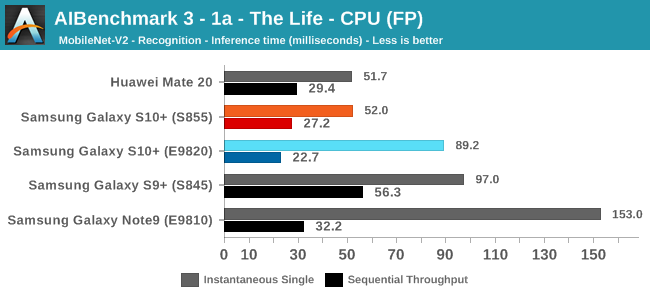
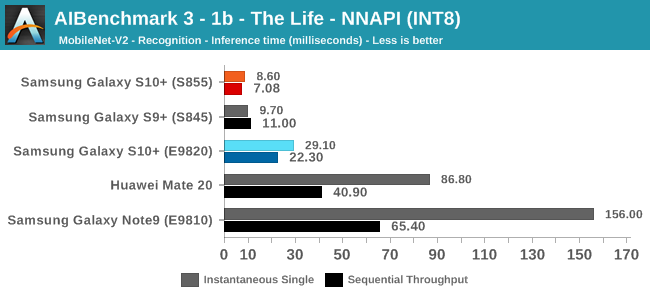
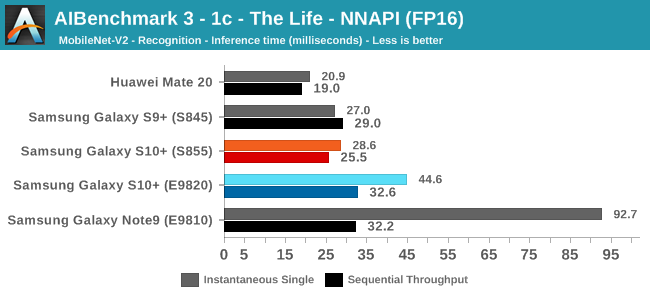

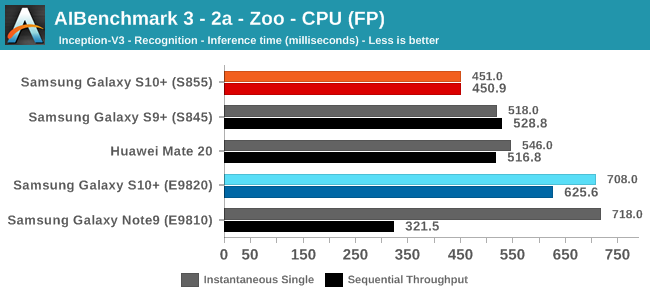
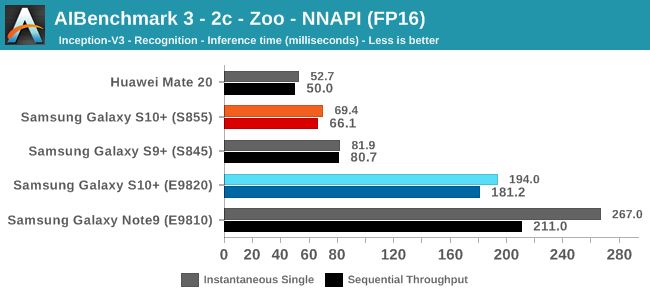
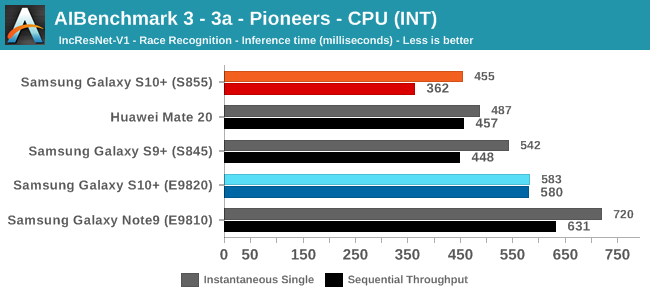
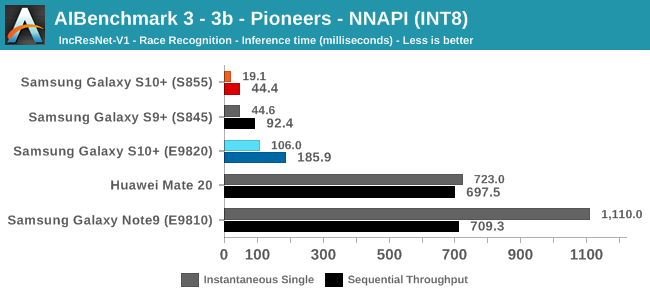
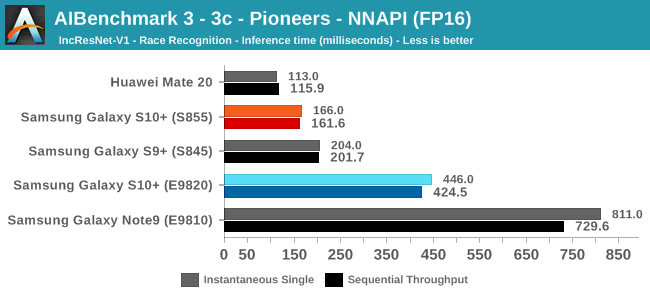

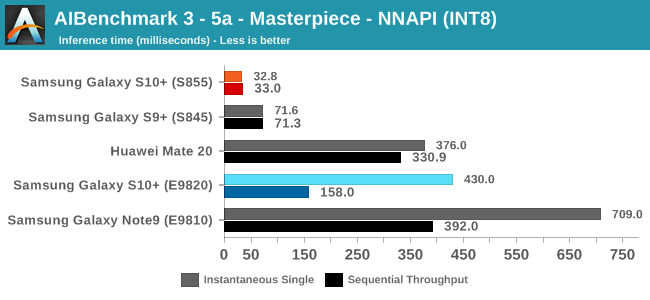
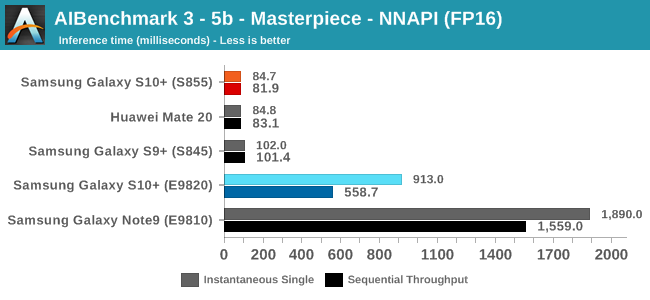
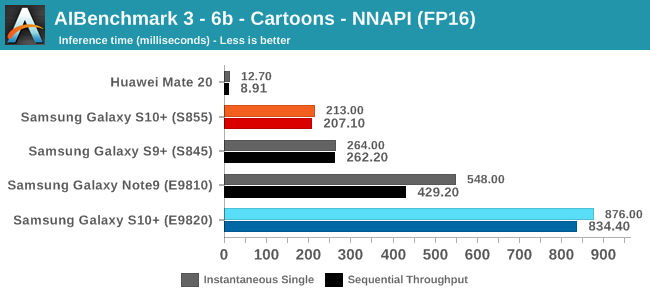






As initially predicted, the results are extremely spread across all the SoCs.
The new tests also include workloads that are solely using TensorFlow libraries on the CPU, so the results not only showcase NNAPI accelerator offloading but can also serve as a CPU benchmark.
In the CPU-only tests, we see the Snapdragon 855 and Exynos 9820 being in the lead, however there’s a notable difference between the two when it comes to their instantaneous vs sequential performance. The Snapdragon 855 is able to post significantly better single inference figures than the Exynos, although the latter catches up in longer duration workloads. Inherently this is a software characteristic difference between the two chips as although Samsung has improved scheduler responsiveness in the new chip, it still lags behind the Qualcomm variant.
In INT8 workloads there is no contest as Qualcomm is far ahead of the competition in NNAPI benchmarks simply due to the fact that they’re the only vendor being able to offload this to an actual accelerator. Samsung’s Exynos 9820 performance here actually has also drastically improved thanks to the new Mali G76’s new INT8 dot-product instructions. It’s odd that the same GPU in the Kirin 980 doesn’t show the same improvements, which could be due to not up-to-date Arm GPU NNAPI drives on the Mate 20.
The FP16 performance crown many times goes to the Kirin 980 NPU, but in some workloads it seems as if they fall back to the GPU, and in those cases Qualcomm’s GPU clearly has the lead.
Finally for FP32 workloads it’s again the Qualcomm GPU which takes an undisputed lead in performance.
Overall, machine inferencing performance today is an absolute mess. In all the chaos though Qualcomm seems to be the only SoC supplier that is able to deliver consistently good performance, and its software stack is clearly the best. Things will evolve over the coming months, and it will be interesting to see what Samsung will be able to achieve in regards to their custom SDK and NNAPI for the Exynos NPU, but much like Huawei’s Kirin NPU it’s all just marketing until we actually see the software deliver on the hardware capabilities, something which may take longer than the actual first year active lifespan of the new hardware.










229 Comments
View All Comments
name99 - Sunday, March 31, 2019 - link
You can from a name and a 2 minute Google search...RSAUser - Saturday, March 30, 2019 - link
"Also, it's probably a good idea to use American English, not British."Obvious troll is obvious.
Gastec - Saturday, March 30, 2019 - link
American English, as in Spanglish?Irish910 - Saturday, March 30, 2019 - link
Maybe you should apply for a job! Did you ever get the concept that many of these writers are probably multi lingual and speak English as a second language. I didn’t know this was a fucking spelling bee.Bottom line, you won’t find any better REAL tech articles than here. Trust me I’ve seen plenty and this site is by FAR the best. So just stop.
don0301 - Sunday, March 31, 2019 - link
From the guy who starts sentences with conjunctions. Your grammar,generally, makes my eyes bleed.piroroadkill - Saturday, March 30, 2019 - link
Why oh why, Samsung? I wouldn't mind a dual-SIM Samsung Galaxy S10e, but it only exists with the shitty chipset. Oh well.asfletch - Monday, April 1, 2019 - link
The G9700 has dual SIM and SD855. That's the S10 model in which I'm most interested. Just waiting for price to drop a bit....AndromedaGalaxy - Saturday, March 30, 2019 - link
Hello Andrei, thank you for your detailed review, maybe the best i have read about the galaxy s10. I live in europe so i can only get the exynos version with valid warranty. I found a promotion for the regular S10 with the exynos and 128 Gb at 750 euros. With all the downsides of the exynos version compared to the snapdragon, do you think it is woth it at that price?Andrei Frumusanu - Saturday, March 30, 2019 - link
I'd wait another month to see how the G8 ends up, but otherwise yea it'd be a good deal.Gastec - Saturday, March 30, 2019 - link
For $1000 ≠ 1000€ will I get the same Google Play Services battery drainer as on my Galaxy S7 This month it decided to use 33%, no 34% as I'm looking at the phone, with NOTHING active or running, just Mobile data :). Google and Samsung in cahoots FTW!